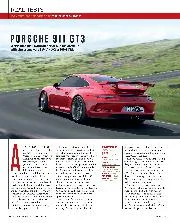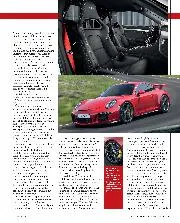

Porsche 911 GT3
Weissach faced a difficult brief but has come up with clever answers | by Andrew Frankel Factfile £100,540 Engine: 3.8 litres, 6 cylinders Power: 475bhp 8250rpm Torque: 324Ib ft @…
MORE ABOUT MOTOR-BOATING
By “PROP SHAFT”
IF any of my readers have doubts about the reliability and effectiveness of the modern type of outboard motors, these should be dispelled by the records established in the Outboard Motor Boat Championship which was held on Oulton Broad on Saturday, July 24th. The championship resolved itself into an international event and there was a very strong challenge from the German team, so strong indeed that three of the four German starters finished in the first six places.
In all, some sixteen boats competed and the race was over a triangular course, consisting of thirty one mile laps. The winner, G. Holt, a young Manchester pilot and a member of the 0.B.M.B.C., had an average speed of 31.72 m.p.h. This would have been even higher hut for trouble in the second heat which lowered his average.
Not only did Holt succeed in staving off the German challenge but he also finished first in each of the three heats, his speeds for these being 32.08, :30.85 and 32.23 m.p.h. It speaks well for the skill of the English pilot and the excellence of his engine that the only time he was passed in any of the three heats was in the second, when G. Kreigeskorte, a twenty-sevenyear-old air mechanic and the ” baby” of the German team, just got his nose in front for a short spell.
It was a great race and was watched by some thousands of spectators who were thrilled and delighted with the splendid dash and hair-raising turns which contributed so much to the winner’s success.
Oulton Broad, where the championship was held, is a favourite resort for motor-boat enthusiasts ; here and on the adjacent water ways hundreds of enthusiasts have been enjoying a life afloat during the last few weeks and the demand for motor craft of all kinds for holiday cruising has broken all records. Similar scenes can be witnessed at many of the popular seaside resorts and while it is true that many of those who have thus been introduced to the joys of motor-boating can only regard it as a holiday pastime, there is also a fair proportion, who, having once been introduced to the sport, will not be content until they have become motor-boat owners themselves.
During the past few months practically every boat yard in the country has been working to full capacity to meet the demand for motor cruisers and the sales possibilities are now so fully recognised that a number of the most important car distributors in London carry agencies for motor cruising craft. These range from the more or less standard type of twenty-footers costing about 000, to the cruisers which represent an outlay of many thousands of pounds.
From the trader’s point of view it should be borne in mind that outboard motors and light inexpensive hulls may be regarded as a means to an end. Outfits of this kind are frequently purchased by those who have little or no experience of the water, but who, after a season or so, acquire sufficient knowledge and keenness to desire a more pretentious craft.
As the tyro gains in experience the tendency is for him to seek an increase of speed.
In the case of launches and cabin craft, this implies a substantial rise in power with a corresponding rise in running costs. When outboards are used the same characteristics do not apply, as, with the modern skimmer type of hull, relatively high speed can be obtained with moderate power and at small cost. This brings us to the question of engines, a subject on which much may be written. One of the first problems which arises is the corresponding advantages
of the two-stroke and the four-stroke ‘engine, and as these notes are mainly intended for the beginner, some explanation of the respective types may be given here.
Briefly stated, the difference between a two-stroke and a four-stroke engine is this : in the former, as the piston rises it not only compresses the mixture above it in the cylinder, but also draws by suction a fresh charge from the carburetter into the crank chamber. Just before the top stroke, the mixture is fired and the piston is forced downwards, thus compressing the charge in the crank case, and a little before the bottom of the stroke it uncovers the exhaust port in the cylinder wall ; the burnt mixture now escapes into the air through the silencer, thus relieving the cylinder of the remaining pressure.
Just at the bottom of the stroke the piston uncovers another port in the cylinder walls, i.e., the inlet port, and, as by this time the mixture in the crank case has been compressed to about 6 lb. pressure per square inch, it rushes into the cylinder and fills it, driving out all the remainder of the last burnt charge ; the piston now ascends, cutting off access to the inlet and exhaust ports, and the cycle is repeated.
The four-stroke engine, being similar to that used on motor-cars, is now so generally well known that it is not necessary to describe it in detail. A point to be noted is that the absence of inlet and exhaust valves and their springs in the two-stroke motor offers an advantage in an open boat where everything is liable to rust up, whilst the working stroke at every revolution enables a cylinder to give out more power.
In proof of this it is estimated that the cylinder of a two-stroke motor with two-thirds of the capacity of the cylinder of a four-stroke motor, will give the same power as the latter.
As a slight set-off against these advantages, the twostroke uses rather more fuel per horse-power, and, moreover, is not so flexible as its rival; that is to say, that, as a rule, it cannot be slowed down quite so much. These drawbacks, however, have no practical weight in the smaller craft, which are practically always run at full speed, for when one’s top speed is in the neighbourhood of five knots why should one wish to slow down ?
Considered theoretically, the two-cycle engine should be superior to its four-stroke rival for marine work, even allowing for its extravagance in fuel as it is simple, robust, and easily made reversible. In actual practice, however, its want of flexibility already referred to, and, in some cases, uncertainty in starting, are points which must be considered.
Two-stroke engine troubles are almost always due to the difficulty of supplying the cylinders with the proper quantity and quality of explosive mixture. To ensure satisfactory running all joints in the petrol vapour system must be absolutely tight. Should there be the slightest leakage between the two halves of the crank case, or at the crank-shaft journals, trouble is bound to result.
A frequent cause of starting failure’s is a poor carburetter design, resulting in liquid instead of vaporised petrol being drawn into the crank case, which in turn supplies an unequal mixture to the cylinders. Continued on page 354
The carburetter should have the shortest possible induction pipe, and be fully adjustable as to jet, choke tube, air intake, and extra air control. The hand-starting gear must admit of the motor being turned rapidly in order to create strong suction through the carburetter, crank case and transfer pipe.
If a two-stroke motor is already installed it may be given a season’s trial, but a four-stroke motor, even if it costs twice as much, is far better value.
As the crank case of a four-stroke motor is not used as a pump, there can. be no reason except cheap production for providing this type of unit with a cramped and inaccessible connecting rod and unadjustable brass bushes for the main bearings.
The crank ease should have doors large enough for the withdrawal of the connecting rod and piston together and the best class engines are so arranged. Similarly, the valve tappets, camshaft and pumps should all be easily accessible separately without disturbing other components. Beware of those designs which are labelled ” compact ” and ” clean” as these terms are very often synonymous with ” skimped ” and “cramped.” A notable addition to the fleet of British owned motor cruisers was recently launched at Gosport. The new boat is the Malahne, built by Camper and Nicholson to the order of Mr. W. L. Stephenson, chairman and managing director of Woolworth’s Ltd. Mr. Stephenson is a keen yachtsman and a
few years ago built the Velsheda racing cutter which has scored many successes in the J class races round the coast.
The new boat is a beautiful example of the latest trend in motor yacht design. It has an overall length of 165 feet with a 26 feet beam and the Thames measurement is 456.6 tons. When completed the Malahne will spend a few weeks cruising in home waters but it is Mr. Stephenson’s intention to undertake extended foreign voyages next year, for which purpose the new yacht is admirably adapted.



